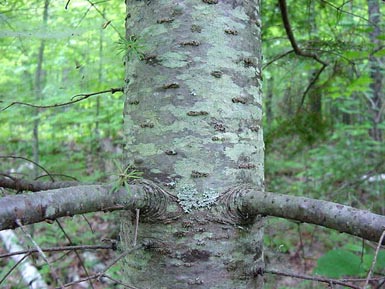Form: This is a small to medium-sized tree that averages 40-80 ft. maximum height and 1-1.5 ft dbh. It is a very symmetrical tree that forms a conical crown.
Needles:
Arrangement: 2- ranked
Length: 1-2" long
Shape: flat; rounded; spreading at almost right angles in 2 rows
Other: hairy twigs; curved upwards on higher twigs; 2 whitish bands below
Bark: The bark is thin and smooth with resin blisters when young, but it develops a scaly brown appearance with age

Cones: The cones are quite small (1.5- 3.25") They are oblong to cylindrical with greenish-purple bracts.
Distinguishing characteristics: In order to distinguish this tree from spruce spp. look for the flattened and 2-ranked (two sets on each side) needle arrangement. The upper side will be darker in color than the lower side. Also look for the resin blisters on the bark of younger trees. Even with age, the bark on balsam fir often stays smooth making the blisters visible.
Range: This is a typical boreal forest species. It is native to the northeast and Lake States, but small populations occur in the southern Appalachians.
Silvics: Balsam grows best in cold climates with abundant moisture. It is very shade tolerant and prolific seed producer. It is often found growing in pure stands.
Ecological and cultural importance: Balsam fir is a very important component in the moose diet. It is also in high demand as a Christmas tree. The lumber is not very valuable. In commercial timber harvest this species usually goes into pulpwood.